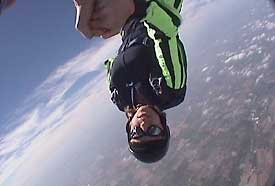There was a time when jumping from an airplane had zero appeal for Michele Pushies.

“My husband, Dan, started skydiving when we lived in California. I thought he was crazy,” says Pushies, a secretary in the Division of Pulmonary & Critical Care Medicine at the Health System.
But when she decided to hang out with some of the jumpers, Pushies noticed something curious: “It was probably the smiles on their faces as they landed. I realized it looked like a fun sport and decided to try it.”
“I’m glad I did,” she says. “For both of us it’s our life and our skydiving friends are like another family.”
For Michele and Dan—a pilot, skydive instructor and BASE (building/antenna/structure/earth) jumper—and their skydiving friends, the sport is safe and fun. The couple jumps nearly every weekend during the summer out of two facilities: Skydive Tecumseh and the Napoleon (Mich.) Skydiving Center.
“Freefall takes about a minute. As a new skydiver you definitely get an adrenaline rush you almost can’t describe,” Pushies says. “On the ground after the first 50 jumps or so, you kind of get shaky from the adrenaline—you just want to scream.”
Now, nearly 600 jumps later, “It’s more about having fun with your friends and enjoying the sport,” she explains.
In June, Pushies hopes to make skydiving history. First, she’ll attend a skydiving camp May 14-15 in Eloy, Ariz. If selected, she will join a group of 25-30 women who will attempt June 24-26 in Chicago to set a new world record for women flying vertical in a formation.
In vertical jumping, skydivers pierce the air at higher rates of speed. They do not fly on their bellies as in traditional skydiving. While building formations, vertical skydivers join together to fly their bodies in a head-down position. The world record for a vertical jump is 16 women.
This season, Pushies also plans to join the all-women parachute demonstration team Misty Blues, which performs at air shows.
Skydivers take pride in learning how to fly their bodies on a pendulum of air. “The forward motion has to be just right,” Pushies says. In skydiver lingo, jumping together is called docking or “building a round.” A “mind warp” involves a jumper in a sitting position who grabs onto another jumper’s helmet while flying vertical.
At the University during the week, Pushies supports eight doctors at the Taubman Center. “I help maintain their schedules, arrange their travel, assist with grant submissions and maintain their divisional/research accounts—basically anything that they need,” she says.
This year, Pushies got an early jump on the skydiving season, which typically runs from April to early November. “I jumped at the beginning of February. It was about 40 degrees on the ground.” Because the temperature falls by 2 degrees for every 1,000 feet of altitude, it was about 20 degrees when she jumped from 10,000 feet.
“Normally you jump at 13,500 feet, unless equipped with oxygen at higher altitudes,” Pushies says. “Anything past that, your oxygen level starts dropping.”
Skydivers use two parachutes: a main and a reserve. “I pack the main parachute. Certified riggers pack the reserve parachute,” she says.
To further promote safety, altitude sensors in skydivers’ helmets beep when jumpers reach 1,000-feet demarcations as they descend, starting at 5,000 feet.
One memorable skydive involved the time Pushies’ mother, Kathie Wellman, jumped in tandem with Dan as Michele flew along side. She even gave her mom a kiss during freefall.
Pushies’ favorite time to jump is sunset. “It’s just beautiful,” she says. “Everything has that orange glow to it.”

